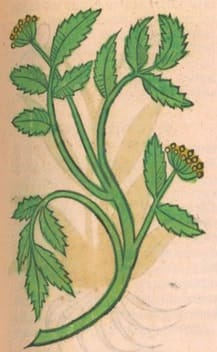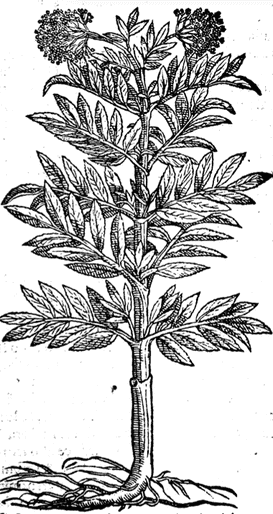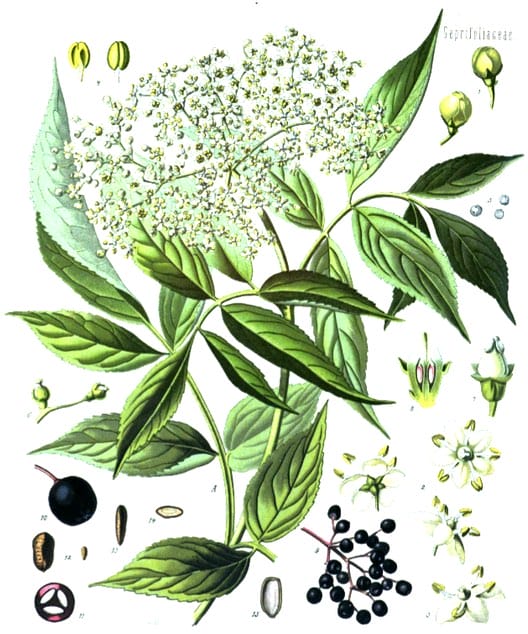Sambucus Cortex, Elder Bark |

|
 Ortus Sanitatis, Meydenbach, 1491
Ortus Sanitatis, Meydenbach, 1491

|

|
|
Della Materia Medicinale, Andrea Valuassori, 1562 |
‘Common’ and ‘Jagged’ Elder Parkinson, Theatrum Botanicum, 1640 |
 Koehler’s Medizinal Pflanzen, 1887
Koehler’s Medizinal Pflanzen, 1887Botanical name:
Sambucus nigra
Parts used:
Bark; Root-Bark
Temperature & Taste:
Cool, dry. Pungent, Sweet
Classifications:
3O. EMETIC
Uses:
1. Clears Wind and Damp, Eases Pain:
-both leaves and bark have been used for Wind-Damp joint disorders including Arthralgia and Lumbago
-strong infusions of the leaf buds have also been used for joint pain and Gout.
-Related species are used for Rheumatic Arthralgia. (Leaves, leaf-buds, root-bark)
2. Clears Damp, Promotes Urine:
-promotes Urine; good for all watery humors, and said to be the best cure for Edema
-cardiac and renal Edema (Bark is strongest; leaf buds are next in strength, then the leaves)
-Jaundice.
3. Promotes Stool:
-constipation, especially in Damp or Cold-type bodies. (Root Bark is strongest; leaves are also used)
4. Clears Heat and Phlegm:
-Epilepsy and Cachexia with heat and damp symptoms.
-clear the skin; for the Itch, Ringworm, Eczema and and Scrofula for which it is used internally and externally;
5. Clears Heat, Promotes Healing:
-Used for Trauma and Fractures.
6. Externally:
-in ointments for Bruises, Sprains, Chilblains, Piles, Tumors, Swellings, Wounds.
-externally for rashes of babies.
Dose
Powder: 300–500mg, up to 1 gram;
Infusion: 1 oz. to a pint, taken in Wineglassful doses;
Decoction: 3–6, and up to 9 grams of the shaved root can be simmered for 5 minutes, then let sit 10 minutes, and strain; Of the Juice: 5–15mls.
Comment:
1. Schroder relays the story of Dr. Martin Bolchwizt, who, in his Anatomy of the Elder, said the Elder could be used to cure most diseases. This has been carried on today where it is often said ‘the Elder is a medicine chest in itself’.
2. All parts have an ‘opening’ (purgative) effect. The Leaf and Flower are mildest in function, and principally promote Sweat. Next the Berries which are best to promote Urine; the Bark or Root bark is more powerful being laxative, and in full doses the inner bark is a hydragogue cathartic.
3. For some indications, different authors used different parts for the same purposes, especially to promote Urine which can be treated by any part of the plant.
4. In Summary:
i. Flowers are principally Diaphoretic, used in acute diseases and Fevers, as well as Cough, Bronchitis, Sore Throat, Asthma and Wheeing
ii. Juice, Tincture or Infusion of the Flowers are sedative and relieve pain
iii. Leaf in general can be used as the Flower, but is stronger to promote Urine.
iv. Berries promote Urine, are slightly tonic, and also resolve Swellings.
v. Bark and Root bark are Diuretic in Edema and Urinary disorders, and Arthritic disorders. Full doses are Cathartic
Main Combinations:
1. Intermittent Fever, with Asarum and Cinnamon (as in Decoction Against Intermittent Fevers)
2. Edema, with Elecampane, Celery root, Valerian, Gentian, Asarum, Squill, Wormwood, Agrimony, Parsley seed, Cinnamon (as in Wine for Edema)
Major Formulas:
Wine for Edema
Cautions:
1. Root bark should not be used in Pregnancy or Yin deficiency.
Main Preparations used:
- Extra Info
-
History
|
‘There are two kinds of elder, one of which grows wild and is much smaller than the other; by the Greeks it is known as the “chamaeacte,” or “helion.” A decoction of the leaves, seed, or root of either kind, taken in doses of two cyathi, in old wine, though bad for the upper regions of the stomach, carries off all aqueous humours by stool. This decoction is very cooling too for inflammations, those attendant upon recent burns inp articular. A poultice is made also of the more tender leaves, mixed with polenta, for bites inflicted by dogs. The juice of the elder, used as a fomentation, reduces abscesses of the brain, and more particularly of the membrane which envelopes that organ. The berries, which have not so powerful an action as the other parts of the tree, stain the hair. Taken in doses of one acetabulum, in drink, they are diuretic. The softer leaves are eaten with oil and salt, to carry off pituitous and bilious secretions. |
‘The smaller kind is for all these purposes the more efficacious of the two. A decoction of the root in wine, taken in doses of two cyathi, brings away the water in dropsy, and acts emolliently upon the uterus : the same effects are produced also by a sitting-bath made of a decoction of the leaves. The tender shoots of the cultivated kind, boiled in a saucepan and eaten as food, have a purgative effect : the leaves taken in wine, neutralize the venom of serpents. An application of the young shoots, mixed with he-goat suet, is remarkably good for gout; and if they are macerated in water, the infusion will destroy fleas. If a decoction of the leaves is sprinkled about a place, it will exterminate flies. “Boa” is the name given to a malady which appears in the form of red pimples upon the body; for its cure the patient is scourged with a branch of elder. The inner bark, pounded and taken with white wine, relaxes the bowels.’ (The Natural History of Pliny, trans. by Bostock and Riley, Vol. 5, 1856) |
